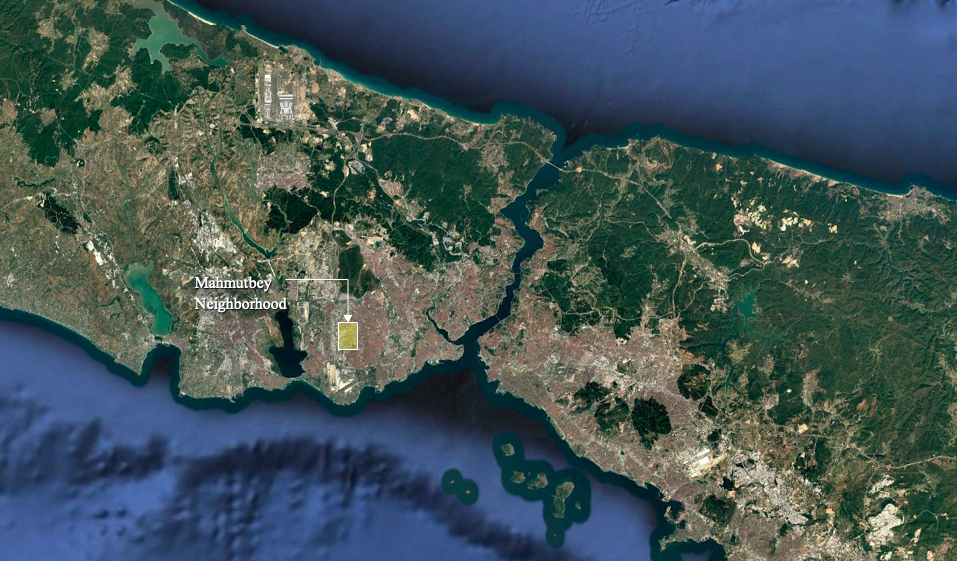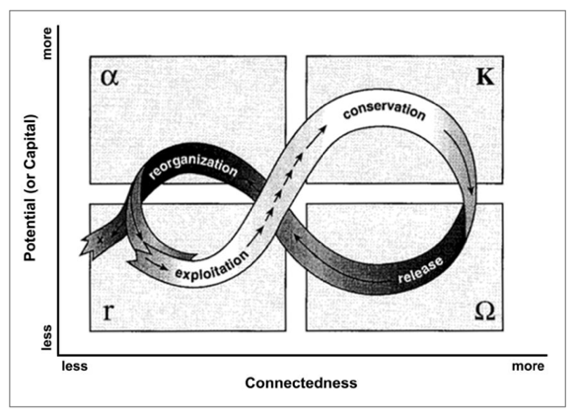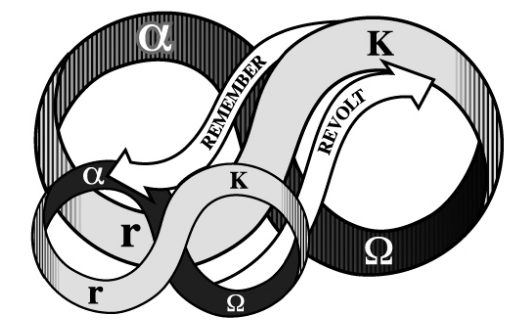Evaluation of Social Resilience Through the Adaptive Cycle Concept in Mahmutbey, Istanbul
ALI ADEL ABDULLAH ALAZZAWI1
1 Altinbaş University, Institute of Graduate Studies, Architecture
Email: theazzawi@hotmail.com
This article is produced from the Author’s master thesis titled " Promoting Social Resilience Cohesion In Mahmutbey, Istanbul "
DOI: https://doi.org/10.53796/hnsj65/11
Arabic Scientific Research Identifier: https://arsri.org/10000/65/11
Volume (6) Issue (5). Pages: 135 - 139
Received at: 2025-04-07 | Accepted at: 2025-04-15 | Published at: 2025-05-01
Abstract: Once a rural settlement on the European side of Istanbul, Mahmutbey has been transformed over the past century from a rural settlement to a highly industrialized urban center. The paper uses the Panarchy framework, a model explaining repetitive cycles of involvement with exploitation, conservation, release, and reorganization of socio-economic and ecological factors, to identify how socio-economic and environmental factors influenced this evolution of the neighborhood. Mahmutbey had historically been a Kalfaköy and is known to have experienced reform after the 1923 Greco-Turkish population exchange. Furthermore, mahmutbey has been changed by the industry's rapid growth in the mid-20th century and has become better connected to Istanbul Center by investing in new infrastructure, such as highway expansions, İSTOÇ Trade Center, and new metro lines. However, these developments have not cleared the neighborhood of traffic congestion, informal housing, abandoned green spaces, social life, and economic inequalities. This paper considers these changes from the point of view of using Panarchy and adaptive cycle concepts, which we can examine to find ways to enhance social resilience on a neighborhood scale and in areas experiencing rapid urbanization, such as mahmutbey was selected for this paper. Studying and understanding Mahmutbey’s current phase of the Panarchy and Adaptive cycle will suggest possible strategies for promoting long-term social resilience to foster the neighborhood's social resilience.
Keywords: Panarchy, Adaptive Cycle, Industrialization, urbanization, Social Resilience.
.
1. Introduction
Industrialization is a known driver of urban growth in cities. It is significant to understand how these communities and transformative change of the neighborhood how local performance reacts within the larger political, economic, and ecological forces, and Panarchy illustrates the shifts between these four phases that make up the adaptive cycle: conservation (K), rapid growth (r), and the reorganization phase (Alpha), release (Omega). This study aims to understand Mahmutbey’s current phase by passing through each adaptive cycle stage to understand the current condition and what strategies need to be implemented later to foster the social resilience of the mahmutbey neighborhood.
2. background
Located in the Bağcılar district of Istanbul, Mahmutbey is a neighborhood that has transformed remarkably from a village to an industrial center in the past century (Nişanyan, 2025; Istanbul Metropolitan Municipality, 2021). Historically, it was called Kalfaköy before the 1923 Greco-Turkish population exchange (Zeybekoglu Sadri, 2020). Following the exchange, Muslim families from Salonica settled in the area, continuing an agrarian way of life. During the mid-20th century, Istanbul’s rapid industrial expansion gradually rationalized Mahmutbey’s landscape from agricultural fields to factories and warehouses (Istanbul Metropolitan Municipality, 2021).

Figure 2.1: Statelet Imagery of Mahmutbey Neighborhood Location (Google, 2025).
3. Methodology
This paper applies the qualitative analysis based primarily on the theoretical framework and secondary Academy resources. The Panarchy was proposed by Holling in (1973, 2001), which serves as a guiding framework for this paper to understand the current condition of the mahmutbey neighborhood to social resilience. The analysis of. Mahmutbey is structured into four adaptive phases, facilitating a comprehensive understanding of the assistance, dynamics, exploitation, conservation, release, and re-organization. Moreover, other Academic resources (Folke et al., 2002; Walker & Salt, 2006; Zhang & Li, 2018) provide the conceptual basis for analyzing the dynamics of social resilience within a rapidly urbanized neighborhood such as mahmutbey.
3. Literature Review
Social-ecological systems have been well characterized through the panarchy framework and resilience theory. Nevertheless, studies based on this framework rarely analyze rapidly urbanizing neighborhoods, particularly in Istanbul. For example, ecological resilience was the focus of previous research, while socio-economic resilience in urban industrial settings was not the ‘focus’ of the research. To fill this gap, this paper gives an explicit look into socio-economic resilience and adaptive capacities in Mahmutbey to contribute ideas to the benefit of urban policymakers.
Panarchy, Mahmutbey’s evolution comprises four interlinked phases:
- Exploitation: The initial agricultural condition and the gradual spatial expansion before the rapid urbanization, characterized as the exploitation phase.
- Conservation: This phase consists of preserving a strong agricultural identity and maintaining a relatively stable local economy.
- Release: Industrial growth disturbs the traditional systems, leading to a shift away from purely agricultural livelihoods. This happened after significant developments, such as the highways and industrial facilities, started.
- Reorganization: The area adapts by integrating into Istanbul’s emerging industrial economy, diversifying economic activities, and shaping new social networks, which is why, with all the significant changes occurring, many social issues and challenges have started to appear in the current phase of mahmutbey.
Each phase represents a period of the neighborhood’s ability to respond to disruptions. The system states that structures and functions of the neighborhood can be identified in phases of the adaptive cycle. Four stages make up the adaptive cycle: conservation (K), rapid growth (r), and the reorganization phase (Alpha) and release (Omega), all integrated within a loop. The adaptive cycle has been used to describe the system condition. These complex systems “consist of relationships between elements at several scales and within nested systems” (Du Plessis 2008, 3).
Design strategies are one factor contributing to thriving and securing the success of a healthy, safe community. Recognizing how social systems function locally and affect border regional and metropolitan contexts is fundamental for evaluating resilience. “Involves combinations of resources and periodically reorganizes to create opportunities for innovation,” and “is a fundamental unit for understanding complex systems to ecosystems to societies to cultures” (Holling 2001, 403).

Figure 3.1: Adaptive Cycle (Adapted from Chapin Et Al., 2009 And Holling, 2001)
- Panarchy and Multi-Scale Interactions
Panarchy focuses on properties that “arise from the interactions between slow-moving and fast-moving processes with extensive spatial reach and more localized processes (Gunderson and Holling 2001, 9).
The cycle can repeat itself across multiple scales. The impact is higher at higher scales, but the changes occur more slowly. The smaller the scale, the lower the influence and the quicker the changes. All these scales are interconnected, and changes at more minor scales can significantly affect changes at higher and larger scales. In the reorganization phase, cumulative capital is released, creating creative destruction opportunities, such as creative deconstructions. In this context, such creative dismantling can foster social development by breaking down existing social systems.

Figure 3.1 : Panarchy (Resilience Alliance 2013).
3. Social Resilience and Adaptive Capacity of mahmutbey
Mahmutbey’s neighborhood transformation stressed local social structures, predominantly migrants who shifted from farming to work in the industrial and service sectors. However, new community organizations, worker cooperatives, and informal support networks emerged to promote skill development and strengthen neighborhood cohesion. Local governance initiatives enhanced adaptive capacity, especially those under Bağcılar’s independent municipal administration.
By placing these dynamics within the resilience theory concerning its social aspect, this paper emphasizes how social systems reorganize to endure shocks and take opportunities (Folke et al., 2002). Finally, Walker and Salt (2006) state that resilience thinking offers further insight into how community structures cope with and restructure environmental and socio-economic shocks. It would support the existing discourse on social resilience in this regard. Such processes show the power of the community to be resourceful by forming partnerships, advocating for infrastructure improvements, and building collective mechanisms to increase the neighborhood’s adaptive capacity. Eventually, these social structures mitigate the disruptive effects of industrialization, leading Mahmutbey to come closer to being viewed as an urban center, from a vulnerable neighborhood into a more integrated urban center.
5. Urbanization and Developments of mahmutbey
In the 1960s and the 1970s, the transition from a rural religion to an industrial center was recorded alongside Istanbul’s broader Metropolitan expansion. Mahmutbey’s urbanization was accelerated by liberal economic policies and targeted industrial investments (Istanbul Metropolitan Municipality, 2021). They performed citywide initiatives, such as the Highway that enhanced regional connectivity, the STOÇ Trade Center, which promoted wholesale commerce, and the Metro Expansion, which improved commuting (Istanbul Metropolitan Municipality, 2021) as Transformative factors that induced release and reorganization processes in Mahmutbey, triggering new social–economic cycles. Because of these land use, property value, and neighborhood composition modifications, communities needed to redistribute resources while supporting policies and developing fresh social connections. This demonstrates that wide-ranging citywide initiatives impact their neighborhoods specifically.
During the Release Phase, İSTOÇ Trade Center and highway construction disrupted traditional livelihoods and led to displacement and formation of informal settlements. The adaptive response included the formation of informal cooperatives and advocacy groups, which were the initial community responses. This exacerbated economic inequalities. In terms of governance strategies, this points out the need to support community resilience during disrupting periods.
Table 3.1 Key Aspects of Mahmutbey’s Urban Evolution
|
Aspect |
Description |
Timeline/Outcome |
|
Rural Administrative Origins |
Initially functioned as a rural administrative sub-district with a predominantly agrarian economy (Nişanyan, 2025). |
Pre-1960s |
|
Accelerated Urbanization |
Rapid industrial growth prompted an influx of labor, dramatically reshaping the neighborhood’s social and physical fabric (Istanbul Metropolitan Municipality, 2021). |
1960s–1970s |
|
Infrastructure Development |
Major projects—highways, the İSTOÇ Trade Center, and extended metro lines—facilitated modern logistics and commerce (Istanbul Metropolitan Municipality, 2021). |
1970s onward |
|
Integration into City Systems |
These infrastructural changes linked Mahmutbey closely to Istanbul’s broader economic and transportation networks (Istanbul Metropolitan Municipality, 2021). |
Cumulative effect |
|
Adaptive Cycles |
Neighborhood-level changes mirrored city-wide adaptive cycles, highlighting the multi-scalar nature of urban transformations. |
Ongoing urban development |
6. Challenges and Future Outlook
The issues that are affecting social resilience in the neighborhood are constantly happening, such as traffic, congestion, unofficial housing in certain locations within this neighborhood, and economic inequality, despite these huge developments that happened before and the current developments that are happening within the neighborhood. Chronic congestion that lowers economic productivity and quality of life is caused by the concentration of industrial facilities and an increase in consignment traffic. Rapid urbanization has also overtaken housing rules, leading to haphazard urban construction and uneven service delivery, with inadequate green spaces. To solve these problems, community involvement and adaptive governance are needed. To sense a balance between industrial operations and residential demands, planners and representatives of local government should focus on mixed-use zoning, improved public transportation systems, and solid social services. Additionally, some documents can be drawn up to strengthen Mahmutbey’s resilience, which involves the opinions of entrepreneurs, long-time locals, and new arrivals. Such an ongoing adaptation based on iterative, collaborative approaches in the face of unreal certainty and novelty is favorable to resilience (Folke et al., 2002; Zhang and Li, 2018).
7. Conclusion
This paper shows that Mahmutbey has moved through the exploitation, conservation, and release phases and is now in the reorganization phase. During this period, the neighborhood accommodates the new conditions caused by industrial development, infrastructure projects, and changing demographics. However, reorganization brings innovation and growth, but serious problems, such as heavy traffic, informal housing, and economic inequalities, persist and must be tackled and continue to be managed. Identifying Mahmutbey as being in the reorganization phase helps local stakeholders plan for future transitions and strengthen social resilience. They are better prepared for the next cycle of change and less vulnerable now and when they face this phase again.
Inclusive policy-making, broader community participation, and improved governance will help the neighborhood to better deal with such changes. The neighborhood evolutions offer valuable insights for such as a rapid urbanized area by applying the Panarchy and adaptive cycle principles to research and practice, which can enable decision-makers to promote a development that aligns with economic progress and community well-being that can foster social resilience in the mahmutbey neighborhood and such similar condition at the neighborhood scale.
8. References
Folke, C., Carpenter, S., Elmqvist, T., Gunderson, L., Holling, C. S., & Walker, B. (2002). Resilience and sustainable development: Building adaptive capacity in a world of transformations. Ambio, 31(5), 437–440. https://doi.org/10.1579/0044-7447-31.5.437
Holling, C. S. (1973). Resilience and stability of ecological systems. Annual Review of Ecology and Systematics, 4(1), 1–23. https://doi.org/10.1146/annurev.es.04.110173.000245
Istanbul Metropolitan Municipality. (2021). Urban development and infrastructure reports. Retrieved March 8, 2025, from https://www.ibb.istanbul
Nişanyan, S. (2025). Bağcılar – Bağcılar – Istanbul. Retrieved March 8, 2025, from https://www.nisanyanmap.com
Walker, B., & Salt, D. (2006). Resilience Thinking: Sustaining Ecosystems and People in a Changing World. Island Press.
Zhang, X., & Li, H. (2018). Urban resilience and urban sustainability: What we know and what we do not know? Cities, 72, 141–148. https://doi.org/10.1016/j.cities.2017.08.009
Zeybekoglu Sadri, S. (2020). Industrialization and urbanization in Turkey at the beginning of the 20th century. Journal of Contemporary Urban Affairs, 4(2), 87–94. https://doi.org/10.25034/ijcua.2020.v4n2-8
Holling, C. S. (2001). Understanding the complexity of economic, ecological, and social systems. Ecosystems, 4, 390-405.
